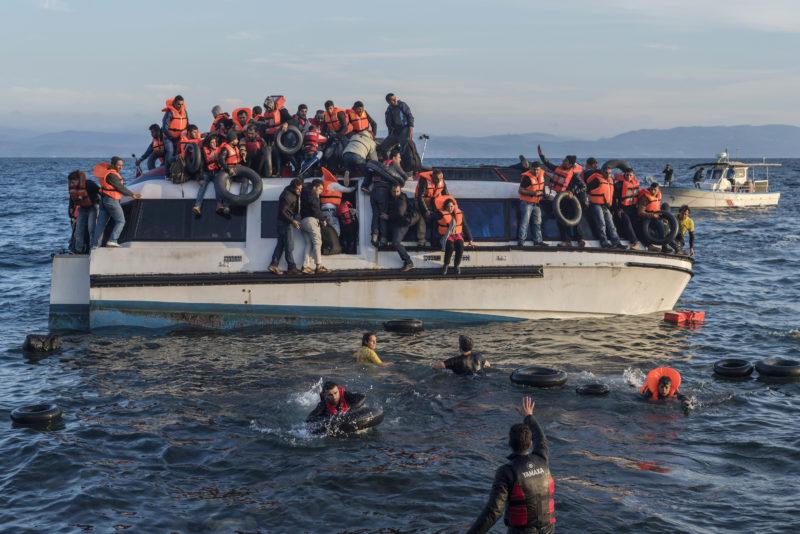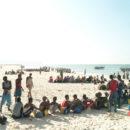Review: Migrant, Refugee, Smuggler, Saviour – by Peter Tinti and Tuesday Reitano

European leaders conflating human traffickers and human smugglers is not just inaccurate. It speaks to the ignorance and/or deliberate manipulation of facts at the heart of their policy responses.

The vast majority of refugees and migrants attempting to reach Europe have done so by sea. Credit: Ggia.
As the mass movement of refugees and migrants to Europe has continued apace − with nearly 350,000 arriving in 2016 to date − officials and leaders have frequently spoken of the urgent need to clamp down on human traffickers. In countless statements and speeches, leaders and ministers have repeatedly made clear their belief that at the heart of the biggest movement of people in Europe since WW2, there lies an “evil trade” plied by “callous gangs”.
When French President François Hollande vowed to dismantle the Calais “Jungle” – an informal camp from which many people try to slip into the UK – he vowed to traffickers “you won’t be trafficking any more”. Meanwhile, in addressing the refugee crisis, former UK PM David Cameron insisted on the need to be “going after the criminal gangs, going after the traffickers, going after the owners of the boats”.
However, while the message of this rhetoric is clear − bad guys, beware − what is much less clear is who exactly it is directed towards.
Because whether through ignorance or carelessness, European politicians and the media have consistently confused “human traffickers” and “human smugglers”. Sometimes the two terms are used interchangeably, and sometimes officials simply say traffickers when they really mean smugglers.
This is not a question of semantics. The two concepts are completely different.
Human trafficking necessarily involves coercion and exploitation and can happen within a single country. The most prevalent examples involve kidnapped women and children being sexually exploited, forced into labour, or used in the illegal organ trade. It truly is an “evil trade”.
Whereas by contrast, human smuggling is a consensual exchange in which a person agrees to be moved across a border, whether by land, air or sea. It is also illegal. It can also be dangerous and involve exploitation. Moreover, sometimes smugglers turn out to be traffickers in disguise.
But the two practices are wholly different, and when politicians use the terms interchangeably, they are conflating the unequivocally exploitative acts of kidnap, rape and enslavement with the much more morally ambiguous act of unlawfully transporting people in need − a practice that thousands rely on every week in their attempts to enter Fortress Europe.
[All the exiled people – where do they all belong?]
Saviours and smugglers
This distinction is rarely clearer than in the new book Migrant, Refugee, Smuggler, Saviour, which delves deep into this latter world and brings alive the complex reality of human smuggling and the many individuals involved in it.
Born of extensive on-the-ground research − spanning from West Africa across to North Africa, Turkey and Eastern Europe − this eminently readable and fascinating work by Peter Tinti and Tuesday Reitano explores how the multi-billion-dollar migrant smuggling industry operates and how it has shifted over the past few years.
Usually when the refugee and migrant crisis has been covered in the media, it is portrayed in what feels like a couple of discreet snapshots. In the first of these, bombs in Syria, repression in Eritrea or poverty in West Africa drive people from their homes. And in the second, these same individuals are now in a boat in the middle of the Mediterranean or stuck at newly-constructed borders in Eastern Europe.
How they got from one to the other has remained much more mysterious or largely been told through the perspective of individual stories. These stories are all unique and worth telling in of themselves − and the book draws heavily on individual accounts − but what has been less well examined is the way in which millions of similar journeys actively transform the political, economic and social landscape across which these voyages are made.
As the authors put it in relation to the migration flows across the Sahara, “a single convoy in the desert creates an ephemeral path that enriches a few. Repeated a few thousand times, it creates a new order of things.”
“A new order” is not an exaggeration. As Tinti and Reitano’s first-hand accounts and analysis show, various towns and regions that have become central hubs in the movement of people have been completely transformed.
In Libya, for example, the proximity of Zuwarah to the island of Lampedusa established it as a major launching point for boats after the disintegration of the state. The economy recalibrated itself around the illicit transportation of people across the Mediterranean, and this in turn has radically shifted the balance of resources and power in Libya’s fractured militia-driven polity.
In Egypt meanwhile, skyrocketing demand − particularly from Syria − pushed the smuggling industry to ramp up and professionalise. This sucked in complicit local security authorities and paved the way for kingpins such as The Doctor, The General and The Captain – all rumoured to be well-connected individuals around whom various myths swirl – to entrench their power and dominate.
And in the arid deserts of Niger, the growing industry generated unrivalled opportunities for job creation and wealth, attracting hosts of young restless men in search of adventure. As the authors write of one interviewee who loves nothing more than posting Facebook pictures of himself posing in the desert with his favourite gun: “If you ask Barka, he will tell you that his current lifestyle is the best he has ever lived. It is dangerous and fun. And most of all, it is lucrative. The alternatives, to the extent that there are any, are boring and unrewarding.”
Barka’s story writ large across the region has remoulded the relationship between smugglers and the state and created a multi-million-dollar economic buffer against instability, Islamist militancy and poverty. “Even if the Nigerien government could crack down on migrant smuggling, they have little incentive to do so,” say the authors.
Through observation, interviews with both migrants and smugglers, and occasionally by treading migratory paths themselves, Tinti and Reitano paint a rich picture of human smuggling and its protagonists across Africa, the Middle East and Europe.
But Migrant, Refugee, Smuggler, Saviour does much more than just leave the reader with a colourful impression. It also unpacks close details of how the industry actually operates, how sophisticated networks have emerged to meet rising demand, and how certain rules and practices govern the business.
We learn how there is a wide array of options for would-be migrants in terms of routes, price scales and quality of service, with those at the highest end able to expect a full package − including all the necessary documents, pickups and even reviews from previous clients − tinkered and tailored to their needs.
We learn how third-party insurers hold migrants’ payments for smuggling services in escrow, only to be passed on once the client reaches their destination. We learn how money can be transferred across huge distances in a matter of minutes via informal but highly sophisticated hawala systems based on networks of ethnicity and trust, and how smugglers get around the practical difficulties of coordinating the transportation of large numbers of people under the radar.
And, amongst much more, we learn how the criminal business has come to permeate the political and security apparatuses of many countries, in terms of profits, personnel and mutually-beneficial partnerships.
Short-sighted
Tinti and Reitano approach the subject matter with the sensitivity of a confidant, the eye of a storyteller, and the analytical understanding of a researcher. However, by the end, they also convey the frustrations of an activist.
The book is certainly not a polemic, but one theme that runs through it is of how successive European responses have been ineffective at best and deeply destructive at worst. And in the concluding chapter, the authors cannot help but take aim at these ill-conceived policies, writing of how “Europe and its allies have doubled-down on short-sighted policies that are more costly and less effective in the long term”.
The highly militarised approach of deploying warships in the Mediterranean, for instance, was found to not “in any meaningful way deter the flow of migrants” by a 2016 British Parliamentary report. Meanwhile, the striking of multi-billion-dollar deals with the likes of Turkey, Sudan and Eritrea to contain migration is not just ethically dubious, but arguably strengthens authoritarian regimes and allows them to hold Europe to ransom.
[Dear Europe, if you really must re-engage with Eritrea, here’s how you should do it]
There are several reasons why Europe has such a poor record of doomed policies, but many can be seen in the simple and seemingly inconsequential way in which leaders carelessly (or perhaps carefully) conflate human traffickers with human smugglers.
Rhetorically and politically, this sleight of hand is savvy. It allows officials to paint a complex problem as one of simple criminality and security, and of good versus evil, but without overly criminalising migrants themselves with whom there may be some sympathy.
But it is a plan based on ignorance if not a deliberate and cynical manipulation of the facts. And as such, policies that derive from this fallacy of equating traffickers and smugglers are more likely to drive smuggling deeper into the criminal underground, further endangering migrants and pushing them towards the very exploitative networks that European politicians purport to be tackling. And all without addressing any of the root causes of the problem or of the need for smugglers in the first place.
All this is not to suggest human smugglers are altruistic heroes − they mostly seem to fall on the spectrum between well-meaning entrepreneurs and professional criminals − but they are, by definition, not traffickers. As the international system has turned its back on some of the world’s most vulnerable people, migrants and refugees have had to turn to illegal alternatives and, as the authors found repeatedly, “smugglers are revered as saviours by many of those they move”.
James Wan is the editor of African Arguments. Follow him on twitter at @jamesjwan.






